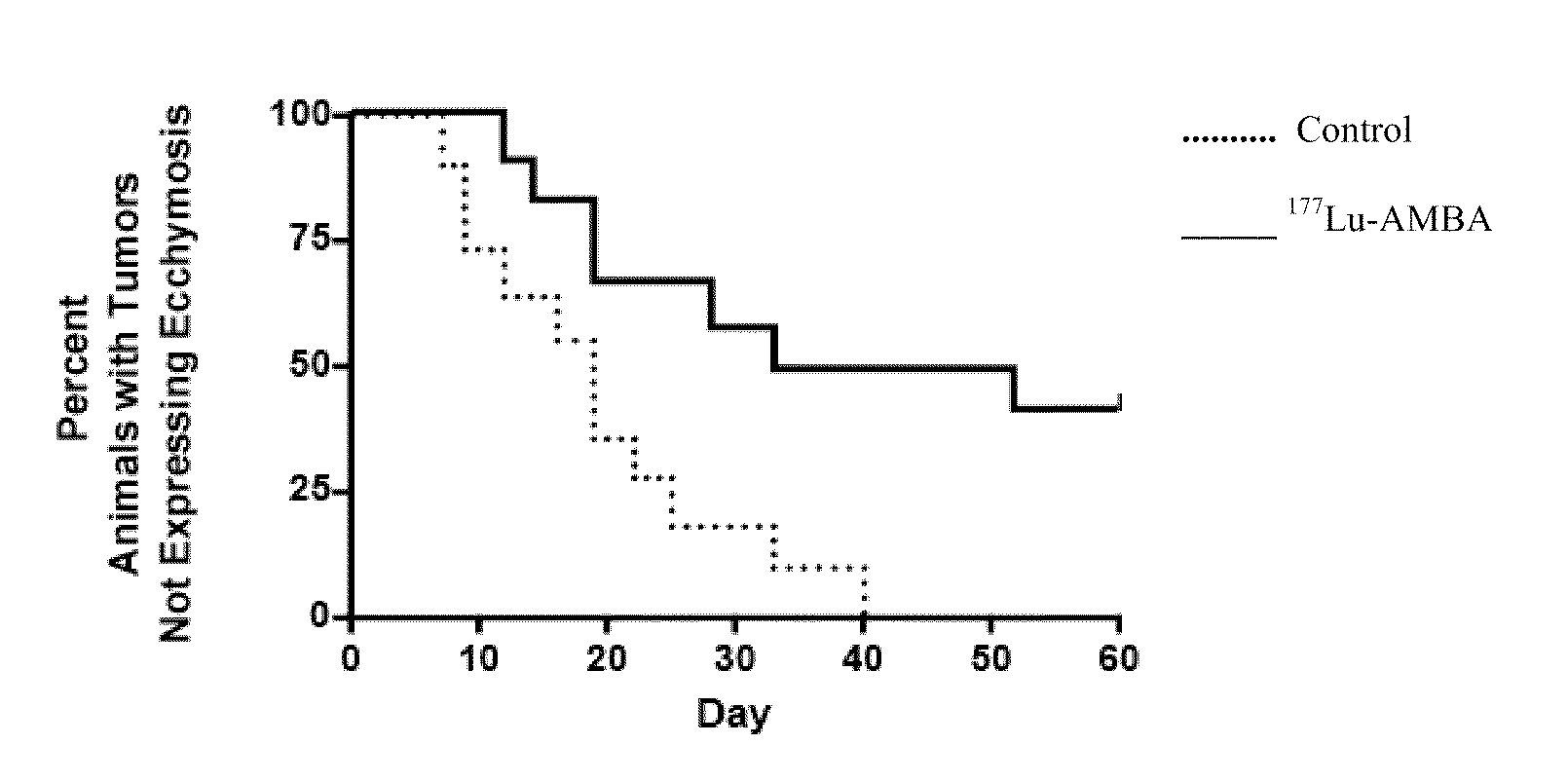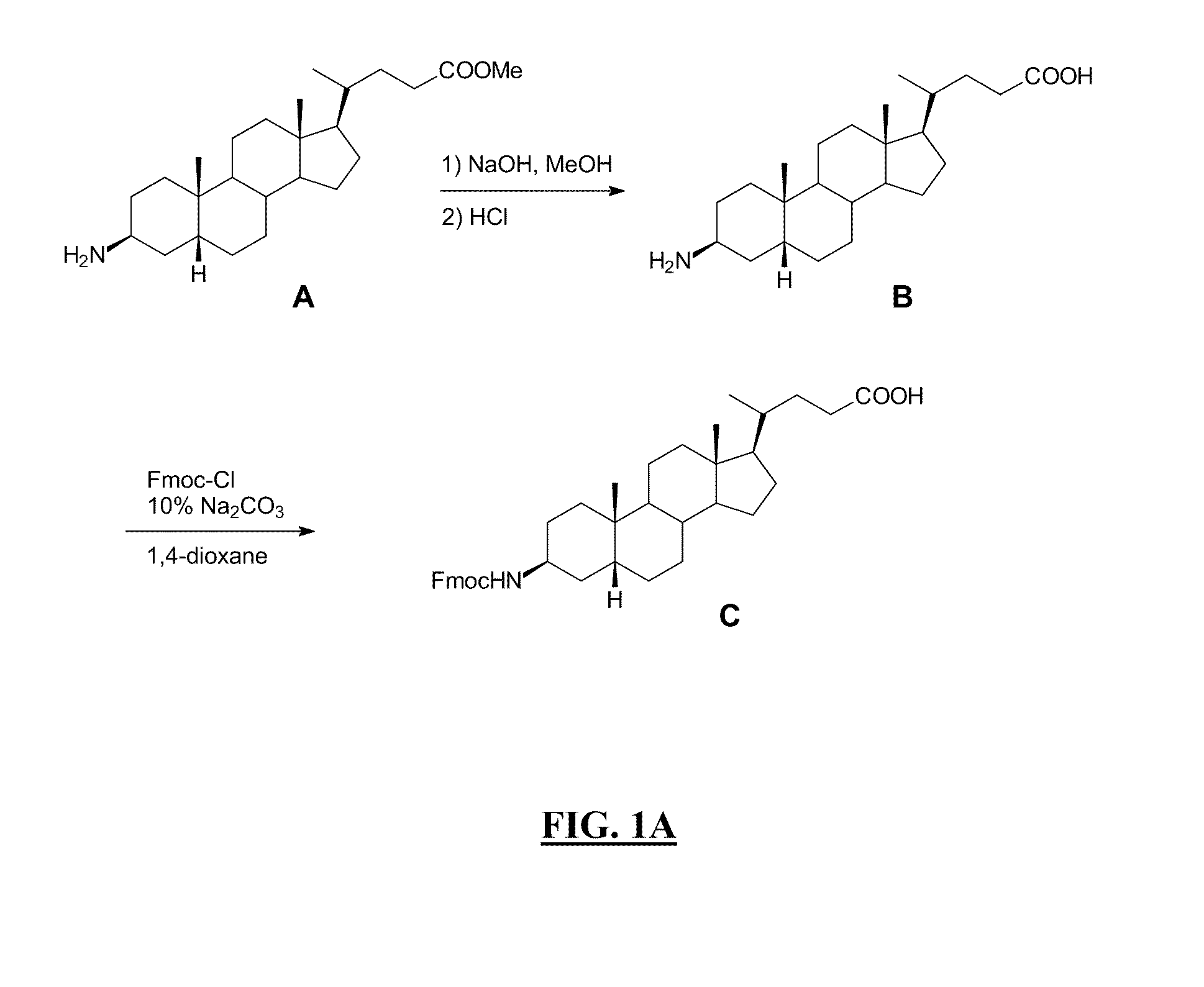Gastrin releasing peptide compounds
- Summary
- Abstract
- Description
- Claims
- Application Information
AI Technical Summary
Benefits of technology
Problems solved by technology
Method used
Image
Examples
examples
[0386]The following are provided as examples of different methods which can be used to prepare various compounds of the present invention. Within each example, there are compounds identified in single bold capital letter (e.g., A, B, C), which correlate to the same labeled corresponding compounds in the drawings identified.
General Experimental
A. Definitions of Additional Abbreviations Used
[0387]The following common abbreviations are used throughout this specification:[0388]1,1-dimethylethoxycarbonyl (Boc or Boc);[0389]9-fluorenylmethyloxycarbonyl (Fmoc);[0390]allyloxycarbonyl (Aloc);[0391]1-hydroxybenozotriazole (HOBt or HOBT);[0392]N,N′-diisopropylcarbodiimide (DIC);[0393]N-methylpyrrolidinone (NMP);[0394]acetic anhydride (Ac2O);[0395](4,4-dimethyl-2,6-dioxocyclohex-1-ylidene)-3-methylbutyl (iv-Dde);[0396]trifluoroacetic acid (TFA);[0397]Reagent B (TFA:H2O:phenol:triisopropylsilane, 88:5:5:2);[0398]diisopropylethylamine (DIEA);[0399]O-(1H-benzotriazole-1-yl)-N,N,N′,N′-tetramethylur...
example i
FIGS. 1A-B
Synthesis of L62
[0431]Summary: As shown in FIGS. 1A-B, L62 was prepared using the following steps: Hydrolysis of (3β,5β)-3-aminocholan-24-oic acid methyl ester A with NaOH gave the corresponding acid B, which was then reacted with Fmoc-Cl to give intermediate C. Rink amide resin functionalised with the octapeptide Gln-Trp-Ala-Val-Gly-His-Leu-Met-NH2 (BBN[7-14] (SEQ ID NO: 1) was sequentially reacted with C, Fmoc-glycine and DOTA tri-t-butyl ester. After cleavage and deprotection with Reagent B the crude product was purified by preparative HPLC to give L62. Overall yield: 2.5%. More details are provided below:
A. Rink Amide Resin Functionalised with Bombesin[7-14] (SEQ ID NO: 1), (A)
[0432]In a solid phase peptide synthesis vessel Fmoc-aminoacid (24 mmol), N-hydroxybenzotriazole (HOBt) (3.67 g; 24 mmol), and N,N′-diisopropylcarbodiimide (DIC) (3.75 mL; 24 mmol) were added sequentially to a suspension of Rink amide NovaGel™ resin (10 g; 6.0 mmol) A in DMF (45 mL). The mixture ...
example ii
FIGS. 2A-F
Synthesis of L70, L73, L74, L115 and L116
[0438]Summary: The products were obtained by coupling of the octapeptide Gln-Trp-Ala-Val-Gly-His-Leu-Met-NH2 (BBN(7-14) (SEQ ID NO:1) (with appropriate side chain protection) on the Rink amide resin with different linkers, followed by functionalization with DOTA tri-t-butyl ester. After cleavage and deprotection with Reagent B the final products were purified by preparative HPLC. Overall yields 3-9%.
A. Synthesis of L70 (FIG. 2A)
[0439]Resin A (0.5 g; 0.3 mmol) was shaken in a solid phase peptide synthesis vessel with 50% morpholine in DMA (7 mL) for 10 min, the solution was emptied and fresh 50% morpholine in DMA (7 mL) was added. The suspension was stirred for 20 min then the solution was emptied and the resin washed with DMA (5×7 mL). Fmoc-4-aminobenzoic acid (0.43 g; 1.2 mmol), HOBt (0.18 g; 1.2 mmol), DIC (0.19 mL; 1.2 mmol) and DMA (7 mL) were added to the resin, the mixture shaken for 3 h at room temperature, the solution was e...
PUM
| Property | Measurement | Unit |
|---|---|---|
| Time | aaaaa | aaaaa |
| Time | aaaaa | aaaaa |
| Time | aaaaa | aaaaa |
Abstract
Description
Claims
Application Information
 Login to View More
Login to View More - R&D
- Intellectual Property
- Life Sciences
- Materials
- Tech Scout
- Unparalleled Data Quality
- Higher Quality Content
- 60% Fewer Hallucinations
Browse by: Latest US Patents, China's latest patents, Technical Efficacy Thesaurus, Application Domain, Technology Topic, Popular Technical Reports.
© 2025 PatSnap. All rights reserved.Legal|Privacy policy|Modern Slavery Act Transparency Statement|Sitemap|About US| Contact US: help@patsnap.com



